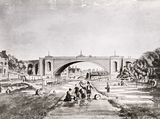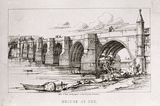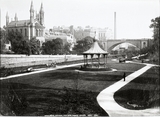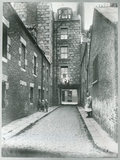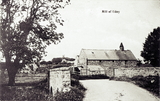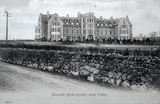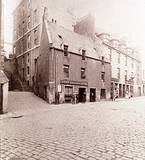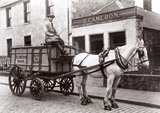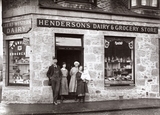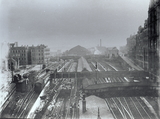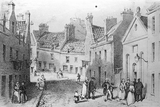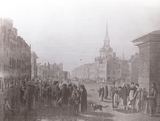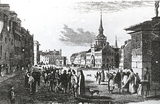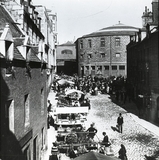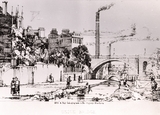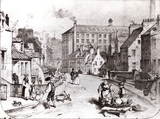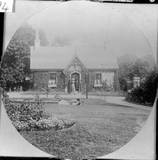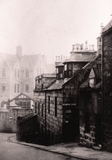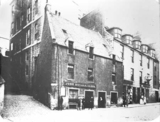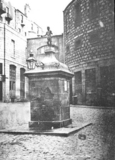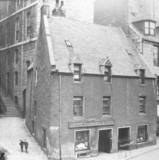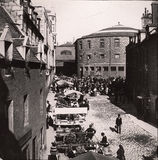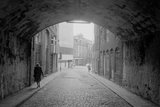|
Quick Search
|
Search Results
You searched for: More Like: 'Mannie in the Green'
271 items
items as
Union Bridge
58 The Denburn looking southward towards and beyond Union Bridge, with the old Bow Brig in the distance and the houses adjacent. The Bow Brig featured largely in the social life of the inhabitants of the area. Note the bleaching green on the right of the print. Illustration taken from a plate drawn by Sir John Carr, 1807 Bridge of Dee
65 The Old Bridge of Dee dating from the early 16th century was begun by Bishop William Elphinstone c.1493. Further building started in 1518 and was carried out by Alexander Galloway and Thomas Franche. In 1840, the bridge was widened by John Smith, the City Architect. Drawing by Curtis Green. Lithograph by Gibb & Hay. Union Terrace Gardens
89 Union Terrace Gardens looking towards the Union Bridge. The spires of Belmont Congregational Church are on the left. The gardens were laid out in 1891-3. The chimney belonged to Hadden's textile factory in the Green. Shuttle Lane prior to slum clearance
193 This 1930s photograph shows the Shuttle Lane slum clearance area situated between East North Street and Frederick Street, before the families were rehoused on new estates.
These houses were typical of the cramped, overcrowded tenements to be found in most Scottish cities. Large families would be crammed into 1 or 2 rooms. There might have been a shared toilet on the landings or more commonly outside in the back yard.
Infectious diseases such as diptheria and scarlet fever could be spread rapidly with such close contact of families, and infant mortality was high. There was often no drying green so many tenements had iron washing poles which could be slid out of windows when needed. Each family would have their allocated day to use the wash house.
Washing clothes was a laborious affair as the mother, maybe with the assistance of an older daughter, would stoke and light the boiler, and trek back and forth with water from an outside tap. Washing would be done by hand and if the weather was bad, then it would have to be hung inside in the kitchen to dry in the heat of the coal fire.
However, it seemed that community spirit was warm and close neighbours helped each other in times of crisis. This was a bond that would be broken when families were rehoused in the modern housing estates. Mill of Udny
208 This postcard image, looking west, shows the Mill of Udny, located not far to the south east of Pitmedden, next to the Bronie Burn. This photograph likely dates from the early 20th century.
The large building shown here, which old OS maps indicate was a corn mill, is still there at the time of writing in 2022. As is the bridge over the Bronie Burn, though its walls appear to have been lowered.
The Mill of Udny is located on a small road, running east to west, between Housieside and Udny Green. The original buildings have been added to and it is now the site of the Mill Business Centre. Aberdeenshire: Donside and Strathbogie, an Illustrated Architectural Guide (2006) by Ian Shepherd indicates that this conversion took place in 1991.
A waterwheel can be seen on the southern side of the mill in this image. Early 20th century OS maps indicate this was powered by a lade, diverted from the Bronie Burn, that ran through the field to the west. A mill dam was once located to the south west across the field.
This image features in the book Old Udny, Tarves and Methlick (2007) by Donna M. Donald. In accompanying information the author states that in 1800 the mill was one of ten working in the Udny area. Donald also states that the mill was built in the middle of the 18th century, "by a forward-thinking laird", and remained in operation until the 1920s. Deeside Hydropathic
209 Deeside Hydropathic at Murtle, five miles to the west of Aberdeen City Centre, was built for the Rev Dr Alexander Stewart in 1899. He had founded a similar establishment in 1874 at Heathcot, Kincardinshire, and the growth of business there led to the selection of this new site close to Murtle Station on the Deeside Railway. It was also seen as a convenient centre for visiting the Deeside area. The extensive grounds included a croquet lawn, bowling green and tennis courts, while the Deeside Golf Club was only a mile away. The building itself had 92 bedrooms, there were Turkish, Russian, vapour, electric and spray baths. Since hydropathy was a medical treatment consisting of the external and internal application of water, the proximity of an artesian well supplying abundant pure water was also a feature. After the first World War, the building was sold and converted into Tor-Na-Dee Sanatorium in August 1918, specialising in the treatment of tuberculosis. More recently it has been used as a convalescent hospital, but it is now being re-developed for housing. Dr Stewart was born in 1835 in Coupar, Angus and studied at Glasgow University and did the medical course at Aberdeen University. At his death in 1909, he was Minister of John Street Congregational Church in Aberdeen, having been ordained there in 1864. The Green
424 The Green. The house occupied by John Buchan, baker, at the foot of the Back Wynd stairs leading up to Union Street was demolished in 1914. In the late seventeenth century the house was owned by George Aedie. Although Boots the Chemist have since relocated elsewhere, the stairs which replaced these are still often referred to as the Boots Stairs because there was an entrance to their premises on the left.
The golden teapot sign that belonged to John Adam's tea and coffee shop disappeared when the shop closed.
Correspondent Ed Fowler investigated the 1904 Post Office directory for Aberdeen to discover more information about the businesses visible in the image. John Adam's premises, with its golden teapot at 64 The Green, can be see on the far right. The tea merchant lived in Hammerfield House, 349 Great Western Road.
The next two entrances to the left, 66 and 68, are for the tenements above the shops. To the left of them at 70 The Green is a drapers called P. & C. Adams. The business also had premises at 47 George Street. D. Cameron, Bakers
442 A photograph of Mr D. Cameron on his horse and cart and outside his bakery and confectioners shop at 76 Skene Square.
This photograph was taken by Kidd & Stridgen of 33 New Market Gallery, Aberdeen.
A copy of this image was kindly lent to the Aberdeen City Libraries for reproduction by William Donald of Udny Green.
Local historian A. G. Duthie has been in touch to suggest that if we look at the Ordance Survey from 1902 (Aberdeenshire sheet 075.11), judging by the shape and position of the buildings, there is a plausible location for this building north of Skene Square School on the other side of the road. Henderson's Dairy and Grocery Store
443 Mr and Mrs Henderson, and others, outside their grocery shop at 21 Chattan Place. Mrs Henderson's maiden name was Prentice.
This photograph was taken by Kidd & Stridgen, a photographers based at 9 New Market Gallery.
21 Chattan place was Kenny's Chip Shop in the 1980s and later a Chinese takeaway restaurant.
A copy of this image was kindly lent to the Aberdeen City Libraries for reproduction by William Donald of Udny Green. Mrs Henderson was the sister of his mother-in-law. The Puffing Briggie
532 A scene of change and renovation in the Denburn Valley. The image looks south from Union Bridge over the suburban platforms of the old Aberdeen Joint Railway Station. The old station's large, curved roof can be seen in the background.
The area we are looking at has seen much change since this time. It is now largely covered by the 1960s retail development on the south side of the bridge, the later Trinity Centre, the development of Wapping Street and Denburn Road, and the building of Atholl House. Though many of the buildings of note we can see in this image are still visible today.
The tall buildings on the far right are the rear of those on Bridge Street. The small street in front of them, going up to Guild Street, is the start of College Street. It is now a partially pedestrianised lane that goes under Wapping Street. The building at the top of this street is the classical style suburban ticket office, built 1909 and now home to Tiffany Hair & Beauty.
Going west along Guild Street's two span road bridge we come to the Great North of Scotland Railway Company's headquarters. This was designed by architects Ellis & Wilson and built in 1894. It is now part of the Station Hotel, along with number 78 next door. The building retains many of its original features. The Guild Street entrance to the Trinity Centre now runs along the western side of this building.
The image also shows features that are no longer present. The covered walkway that can be seen on the near right of the image enabled direct access from the station's central platform to the Palace Hotel on Union Street. The hotel was owned by the Great North of Scotland Railway Co. (GNSR). The walkway was vaulted to pass over the tracks at sufficient height.
Consulting The Joint Station: Aberdeen Station, 1867-1992 (c1992), this image probably dates from 1912 when, in additional to commencing the reconstruction of the Joint Station, the GNSR also laid new loading docks and carriage storage siding in the Hadden Mills site (left of image). This was to ensure that the main station buildings were used purely for passenger traffic.
The walkway that linked Windmill Brae and the Green, known affectionately as the Puffing Briggie, can be seen in the centre of the image. It looks like a section on the left has been temporarily demolished as part of the ongoing work.
The sidings on the extreme left were used for cleaning carriages in the later 20th century. One of our correspondents recounts using the often-unattended carriages, accessible when entering the station from the Green, as an unusually exciting and plush playground during their youth in the late-1940s. Back Wynd Stair, The Green
596 The Back Wynd stair is so named because, before the making of Union Street, the Back Wynd came right down from Schoolhill to The Green. The stairway was re-designed in the 1930s. Albion Street
667 Albion Street, also known as the Bool Road because it led to the bowling green. It led to the Links from the foot of Justice Street. On the right hand side is the mission chapel which in 1848 replaced the "penny rattler", a street theatre which gave the area a bad reputation. It later became Albion Street Congregational Church. The area was cleared in the 1950s for the development of the Beach Boulevard. Irvine's view of the Castlegate
669 This view was painted by Hugh Irvine of Drum. The Market Cross is located opposite the Tolbooth and the structure on the right is the base of the street well, popularly known as The Mannie in the Green, because it was moved to The Green in 1852 and re-appeared in the Castlegate in the 1970s. It was the first public well erected in the city in 1706. Irvine's view of the Castlegate
675 This view was painted by Hugh Irvine of Drum. The Market Cross is located opposite the Tolbooth and the structure on the right is the base of the street well, popularly known as The Mannie in the Green, because it was moved to The Green in 1852 and re-appeared in the Castlegate in the 1970s. It was the first public well erected in the city in 1706. Market day in The Green
686 The curved wall of the popular New Market dominates this view while farming folk are gathered round the 'Mannie in the Green' street well to sell their butter and eggs, vegetables and flowers at the Friday market. The New Market was demolished in 1972 to be replaced by the Aberdeen Market, and the 'Mannie' returned to his orginal home in the Castlegate. The Denburn Valley, showing Union Bridge
691 The Denburn Valley, showing Union Bridge. The chimney belonged to Hadden's textile mill in the Green. Watson Street Lodge
733 A photograph of the Watson Street Lodge in Victoria Park.
The figures standing in the doorway are most likely to be Robert Walker (1848-1930), the Keeper of Victoria Park, and his family; his second wife Christina Walker and daughters Elizabeth and Ann. Judging by the 1891 census and Robert's eventual obituary, the family also had at least five sons.
Walker was previously married to Isabella Robertson. She died on 24th November 1877. This photograph likely dates from the later 19th century.
Robert Walker was originally from Perth and was himself a son of a gardener. He came to Aberdeen as a nurseryman and in around 1871 was chosen out of 450 candidates to be the city's first keeper of parks.
He oversaw the creation of Victoria Park, Aberdeen's first public park, before going on to lay out Westburn Park, Stewart Park, Union Terrace Gardens and the Promenade. Walker was also an early advocate and pioneer of the planting of street trees.
For a number of years Aberdeen had two superintendents of parks, Walker and a Mr Peter Harper at Duthie Park. When Harper retired in 1914 Walker was appointed general superintendent.
Post Office directories indicate that Walker and his family lived at the Watson Street Lodge, also known as the Victoria Park Lodge, from its construction in around 1872 to his retirement in 1919. His residence at the lodge was part of the job. On retirement Walker moved to the relatively nearby 111 Westburn Drive.
He was succeeded as general superintendent of parks by William B. Clark, who resided at the West Lodge of Duthie Park. A man called Robert Duncan replaced Walker as the keeper of Victoria and Westburn Park.
Over the years Aberdeen has had substantial success and renown as an attractive, green city. A considerable portion of the credit for this success must reside with the pioneering and dedicated work of Robert Walker. Jack's Brae and March Lane
773 A photograph looking south east down Jack's Brae, past March Lane, towards upper Denburn in 1927.
The Ordnance Survey town plan from 1866-67 indicates that the buildings at the foot of Jack's Brae, beyond March Lane, and shown in the centre here, had a tannery to their rear. All these buildings on Jack's Brae were demolished and the land is now a green space.
The substantial granite building in the background on the left is Skene Street School, later known as Gilcomstoum Primary School. The wall that can be seen at the junction of Upper Denburn remains at the time of writing in 2022.
A city royalty boundary stone, marked "CR" can be seen underneath the March Lane street sign. John Buchan, baker, The Green
785 John Buchan, baker, The Green. This building, also known as Aedie's Lodging, was reputed to be the building in which children who had been kidnapped for the slave trade in America were held in the 18th century. The most famous of these was Peter Williamson. On the left is the stairway leading to Union Street. Mannie in the Green
789 The Well in the Green historically important from being connected with the fiirst introduction of a regular water supply into the city in 1706. It stood originally in Castle Street. It was taken down about 1840 but then re-erected in the Green in 1852. It is now to be found in the Castlegate opposite the Town House. John Buchan, bakers, The Green
790 John Buchan, baker, The Green. This building, also known as Aedie's Lodging, was reputed to be the building in which children who had been kidnapped for the slave trade in America were held in the 18th century. The most famous of these was Peter Williamson. On the left is the stairway leading to Union Street. Correction Wynd
894 A late 1970s or early 80s photograph looking south along Correction Wynd towards the Green and the indoor market. The arch above is that which takes Union Street over this lane.
The Union Bar can be seen in the distance on the corner of Hadden Street and Carmelite Street. The pub closed down in 1968 and its block was demolished likely not long after this photo for the widening of the Hadden Street access to the Green and a new residential development. |



